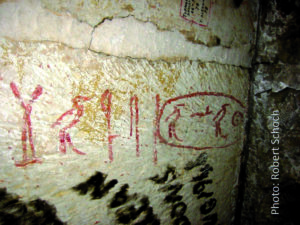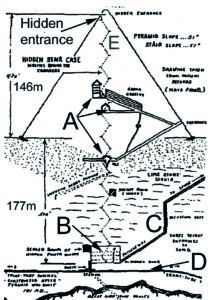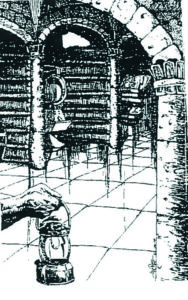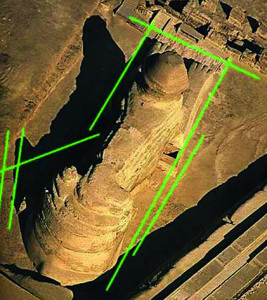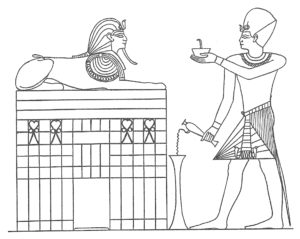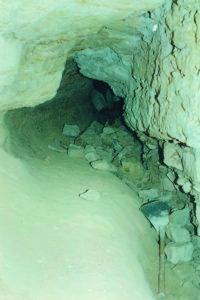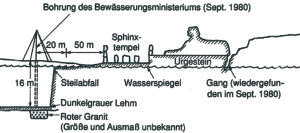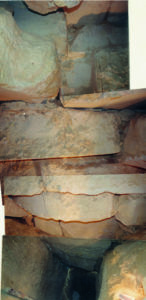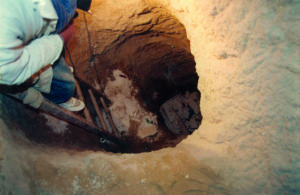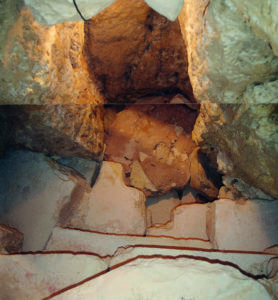Discoveries from 1912 to 1988
1912 – Sphinx chambers discovered by Dr. Reisner, Harvard University
The first sensational discovery was published by the American Egyptologist Prof. George Andrew Reisner from Harvard University. At the beginning of the 20th century, he conducted research and excavations on the Giza Plateau for more than 10 years, mainly around the „Mykerinos“ Pyramid, the „Chephren“ Valley Temple, the Sphinx Temple and the Sphinx. He then published two documentaries in 1912: „Solving the Riddle of the Sphinx“ and „The Dawn of Civilization in Egypt“.
It states, among other things, that he discovered a „temple dedicated to the sun“ inside the Sphinx, which is older than the pyramids and which he considers to be the oldest building in Egyptian history.
In another room within the Sphinx is buried the Menes, 1st Pharaoh, who declared himself a god and let the Sphinx cut out of the surrounding rock.
He also refers to an opening in the head of the Sphinx, which is closed with a stone lid and which is still clearly visible on aerial photographs today.
„ […] a hall 60 feet long and 14 feet wide.“ The room is connected by corridors with the sun temple, which lies between the front paws of the Sphinx.
Inside the Sphinx there are „ […] caves and buildings that suggest that their mysterious giant body belonged to a gold-jumping city. Numerous tunnels lead into the caves of the interior, into which one could not yet penetrate […] „
In chambers in the Sphinx he had found small pyramids which prove to him that this form from sacred geometry was known long before the construction of the great pyramids.
In his further research among the relics inside the Sphinx, Professor Reisner hoped „to discover many secrets of Egyptian priests and to open up a new early era of Egyptian culture to the world after thousands of years.“
But he published nothing more about these fascinating discoveries.
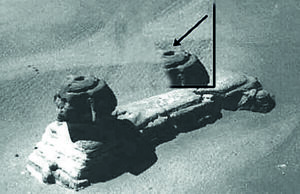
Sphinx – The head with the hole in 1926, before Émile Baraize, who worked on the Sphinx from 1925-1936, used an iron lid.

Sphinx – The Sphinx head today, with the lid used by Emad Fahmy in the nineties. He said the shaft was about 1.5 m / 5 ft deep.
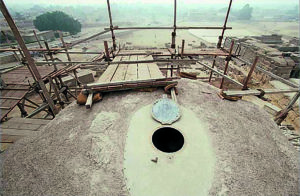
EGYPT – MAY 01: This hole on the back of the Sphinx was dug by robbers who hoped to find some treasure inside the monument in Cairo, Egypt on May 01, 1990. (Photo by Eric BRISSAUD/Gamma-Rapho via Getty Images)
1931 and 1948 – Founding of the A.R.E. and ECF
For the evaluation and research of the information received while in trance, Edgar Cayce founded the Association for Research and Enlightenment in 1931 (A.R.E.). After the death of Edgar Cayce, his oldest son, Hugh Lynn, formed the Edgar Cayce Foundation (ECF) in 1948. Over the years, he found sponsors who were prepared to finance scientific research in Egypt. The first project was undertaken from 1973 to 1976. It is remarkable that the leading archeologist in Giza, Professor Mark Lehner, is a son of Cayce followers, and was supported with an ECF scholarship. During the ominous years from 1996 to 1998, a Cayce follower and multimillionaire promoted important research in Giza. But, first things first…
1934 – Discovery of the “Water Shaft” or „Osiris“ Complex
From 1929 to 1939, the Egyptian archeologist, Dr. Selim Hassan, conducted numerous excavations in Giza. He made a significant discovery while excavating the causeway from the Chephren Valley Temple to the “Chephren” Pyramid. In a tunnel located beneath the causeway, they found a shaft that led vertically into depths below the causeway: the triple-level shaft structure that is known as the Osiris Tomb today (see page 104). Selim Hassan descended and managed to reach the second level. In the report he wrote at the time it says:
“At the bottom of this shaft is a rectangular chamber, in the floor of the eastern side of which is another shaft. This descends about 14 m / 45.9 ft and terminates in a spacious hall surrounded by seven burial chambers in each of which is a sarcophagus. Two of these sarcophagi, which are of basalt and are monolithic, are so enormous that at first we wondered if they contained the bodies of sacred bulls. In the eastern side of this hall is yet another shaft, about 10 m / 32.8 feet deep, but unfortunately it is flooded.” (Extract from Excavations at Giza, Vol. 5, 1933 to 1934, Cairo Government Press, Bulaq 1994; as published on the Internet by Nigel Skinner-Simpson).
In his excavation report, Selim Hassan wrote that all seven niches on the second level contained sarcophagi, whereby he emphasized two of which were monolithic („a spacious hall surrounded by seven burial chambers in each of which is a sarcophagus. Two of these sarcophagi […] “). During the official investigation of the shaft in 1996, only these two gigantic sarcophagi remained, which are made of black granite, not basalt, as Hassan conjectured. Did he also make a mistake in regard to the other sarcophagi or did a misunderstanding occur in the excavation report? If not, then the question remains concerning where the other sarcophagi went in the intervening 60 years.
The discovery of the underground structure, which was reported in a series of newspaper articles in 1935, excited the fantasy and spirit of exploration among esoteric circles, particularly the Rosicrucians. The “Imperator” of the AMORC (Ancient and Mystic Order Rosae Crucis) at the time, Dr. Harvey Spencer Lewis (deceased in 1939), published in 1936 the book, “The Symbolic Prophecy of the Great Pyramid“, in which he mentioned the discovery of the shaft structure (see page 179). In this book, he claims that the shaft contains many wall paintings and statues, reminiscent of the period of the Pharaoh Echnaton, who the Rosicrucians consider to be one of their most important trailblazers. With this rather inaccurate description, Lewis apparently was attempting to align the discoveries made by Selim Hassan with his own traditional concepts.
The construction of the Aswan Dam (built 1960 to 1971), caused the water table to rise by 8 m / 26.3 ft as a result of the damning of the Nile, which also led to the flooding of the 2nd level of the Osiris Tomb. The water was so clear that the shaft could also be used as a well, which led to it being named the “Well Shaft“ in the seventies. In the mid-1980s, an attempt was made to pump out the ground water, which also threatened the Sphinx, and to keep it out permanently. In 1996, this even led to the gaining of access to the third level.
On March 2, 1999, the American television network, Fox, presented the discovery of the shaft structure to millions in a program entitled, “Opening of the Lost Tombs“. The show starred Dr. Zahi Hawass, who had played a leading role in Giza since 1974 (see page 189). He was depicted as the discoverer of the structure and as a great authority in contemporary Egyptology. Hawass stated that the shaft was a symbolic “Osiris Tomb” that was built in two phases from 1,500 to 500 years before Christ.
1936 – Publication of subterranean maps
Dr. Harvey Spencer Lewis was a co-founder of the AMORC (Ancient and Mystic Order Rosae Crucis) in 1915, and in his book “The Symbolic Prophecy of the Great Pyramid“, published in 1936, mentioned the underground complexes below the Sphinx. He named as his source secret manuscripts from the ancient Egyptian schools of mystery. In the following year, a high-ranking member of the order “Knights Templar of Aquarius”, H.C. Randall Stevens, published sketches of subterranean structures in Giza for the first time (see page 115).
1937 – Discovery of the Chufu cartouche by Howard Vyse
In 1765 the British diplomat Nathaniel Davison had discovered a mysterious chamber in the Great Pyramid above the „King‘s“ Chamber and since the late 18th century it was thus documented that a narrow tunnel leads from the end of the gable of the Great Gallery to a flat chamber that can only be reached by crawling.
Howard Vyse set out in 1937 to find more chambers and used explosives in his notorious manner, as he did at the entrances to the Great Pyramid and the Small Pyramid and on the back of the Sphinx.
He discovered four more so-called „Relieving“ Chambers (see page 48) and another sensation: the only hieroglyphs in the 3 pyramids, apparently left behind by the workers of the pyramid construction. They are names painted in red in cartouches and one of them – in the upper „Campbell“ Chamber – stands for Chufu (Khufu, Cheops), which was then read as Suphis.
Zecharia Sitchin declared these quite primitively painted hieroglyphics in his book „Stufen zum Kosmos“ (stairs to the cosmos) as a fake of Vyse for two reasons:
1. the name of Cheops, Egyptian „Ch-u-f-u“ is misspelled, because the hieroglyphic sign „Ch“ is not represented with a hatched but with an empty circle. Therefore the name is to be read as „Ra-u-f-u“. Sitchin also provides his explanation: Vyse had copied the hieroglyph from the then popular textbook „Materia Hieroglyphica“, in which the name Chufu as builder of the Great Pyramid was incorrectly depicted in a cartouche. He based this on a copy of the cartouche exhibited in the British Museum.
However, all hieroglyphics from the 4 chambers were published after their discovery by Vyse as well as by Perring, and in 1931 they were also published by Reisner. All three printed the King‘s cartouche correctly with the hatched circle.
2. the hieroglyphs are written in semi-hieratic or linear-hieroglyohic letters. He refers to the Egyptologist Samuel Birch, who already in the year of Vyse‘s discovery pointed out that this spelling was only used centuries later and had not yet been known in the Old Kingdom.
Contemporary research, however, has shown that the spelling was already widespread centuries before Cheops in the Thinite period, something Birch could not have known at that time.
As proof for Vyse and against Sitchin it is also stated that not only the cartouche for „Ch-u-f-u“, but also other hieroglyphics were found in the 4 chambers, with names of worker columns as well as height and axis lines.
Sitchin‘s supporters point out that only 4 out of 5 chambers contain hieroglyphics, exactly the 4 upper ones discovered by Howard Vyse. The first and lowest, the „Davison“ chamber, which was discovered long before, does not contain any characters.
Sitchin‘s assertions were denied by the Egyptologists from the beginning, not least because this would take away one of the few „proofs“ for the construction by Cheops.
Since Michael Haase published a convincing counterstatement in 1996, I – like some other border-scientific researchers – have been of the opinion that the cartridges themselves are genuine.
Even if the hieroglyphics and spellings are real, this does not necessarily mean that they could not have been applied later in the time of Cheops. Because the advocates say that there was no access before Vyse‘s discovery. But there was probably a secret passage (see page 221 at 1996 Hawass).
Reference:
My personal comment on the „cartouche scandal“ of Dominique Görlitz and Stefan Erdmann in 2014.
Their idea for a laboratory test of the painted color to get an actual age determination was a good idea and could provide an important additional component to assign the hieroglyphics.
But after their examination in the Great Pyramid, there was a scandal because they had apparently damaged the King‘s cartouche of Chufu. They demonstrably did not do this because they took the color sample from another cartridge. But they worked really questionable to unprofessional. On the one hand, they took too small a quantity of the color sample, which meant that the Fresenius Institute in Germany was unable to provide any results. On the other hand, they had a licence for the „King‘s“ Chamber, but not for the „Relieving“ Chambers. After their return to Germany, they immediately posted a video of their „heroic deed“, which was also seen by officials in Giza, what resulted in 6-9 Egyptians being imprisoned for almost 2 years. All this did not lead to any useful result, but to great confusion and arrests of innocent people, and since then the work in Giza has been difficult for all other researchers.
Note:
It is also interesting for me that the stone slabs in the ceilings of the „Relieving“ Chambers are perfectly flat and smooth on the underside. However, the floor area of the chambers is completely uneven, because the floor blocks protrude from the floor at different heights, as if by chance. Exactly as in the rear area of the „Cistern“ Chamber (see page 38 ff.).

“Cheops” Pyramid – Cross section of the upper chamber with the hieroglyphs going over corners. In red, one of the marking lines.
1938 – Discovery of unknown chambers in the Great Pyramid by J.O. Kinnaman and W.M.F. Petrie
The American, John Ora Kinnaman, was editor-in-chief of the „American Antiquarian Society“ and the „Orient Journal“ as well as a journalist in various specialist journals. He was also the founder of a foundation still operating today under the name „Kinnaman Foundation for Biblical and Archaeological Research“.
According to his own statements and depending on the source, Kinnaman travelled eight to ten times to Egypt, six times with W. M. Flinders Petrie (the more famous Giza researcher was a member of the same Freemasons lodge), twice with James Henry Breasted and once with Howard Carter (the discoverer of the tomb of Tuthanchamun in the Valley of the Kings near Luxor), but even today there are still no documentations for these journeys.
The Director of Research of the above mentioned foundation, Stephen Mehler (a member of the Rosicrucian Lodge, who also publishes as an author), tried to arrange the estate of Kinnaman and found a tape in 1979. It is the recording of a conversation by Kinnaman in the Masonic Lodge of California in August 1955, in which he tells of explosive discoveries he made together with Petrie in the Great Pyramid in the spring of 1938 when they entered a large chamber (the American sources say that they found the entrance by chance, almost all German sources write that the room had been known since 1925, but not which one it was). He tells of other chambers, but said nothing about their location – except that they were accessed from the south – and told of parchment rolls with hieroglyphics and rolls in writing unknown to them. In addition, unknown apparatus dating from the Atlantic period was used to build the pyramids. He concluded that the Great Pyramid was built 35,000 years ago and contains evidence dating back 45,000 years.
When a listener asked why they had not published this discovery or submitted parchments, Kinnaman replied that he had come to the conclusion with Petrie that humanity was not mature enough for this information at the time and that they swore an oath not to publish this discovery. They had been together in the chamber four more times, but there is also no publication or documentation about it beside the tape recording. Mehler also found it strange after his investigations that he could not find a single connection to Kinnaman in Petrie‘s records. Opinions still differ as to whether this discovery is true, because Kinnaman enjoys credibility through his life‘s work on the one hand, and there are documents from the family environment that raise doubts on the other.
Note:
In my opinion, it could best be the Chamber of Knowledge (see page 55). Sometimes a map of this conversation is shown on the Internet (see Fig. 7.8 on page 193), which was published in 1978 by David H. Lewis in his book „Mysteries of the Pyramids“. But I don‘t think that this is one of the descriptions of Kinnaman, because it shows an access via the top of the pyramid.
1940 – Blasting and digging in the Cistern Chamber by Vyse
As early as the 1840s, the Briton, Howard Vyse, had the vertical shaft blown up and dug up in the Cistern Chamber because he suspected further chambers there. They reached a depth of almost 9 m, where the pit in the rock narrows considerably. Then they would have stopped, depending on the source, because there was no prospect of a passageway, because they thought it was a grave robber shaft or because the workers refused to continue digging. In the 1990s, the shaft was freed of sand twice more and it was dug somewhat deeper down to around 11 m. Then it was probably refilled, although due to some documentation it is more likely that a lid was inserted and covered with sand. But so far no passage has officially been found, which leads deeper into the underground.
Notes: The French archaeologist, Dr. André Pochan, calculated in 1971 in his book “L’énigme de la grande pyramide” that the Nile could be discharged at its groundwater level about 27 m below into the complex. In this context, he refers to a description by the Greek historian Herodotus (see page 166), where he reports that he was told of “underground chambers at the height where the pyramids stand. The chambers are supposed to be the burial chambers of Cheops, and he built them as islands by leading a Nile channel into the mountain…”
Some researchers conclude that this was the “Campbell” Shaft because a ring of Cheops was also found there and later served as a well (see page 89).
Herodot spoke for me of the so-called “Osiris Tomb” (see page 90), whose lowest chamber is about 30 m deep in the rocky subsoil and the sarcophagus was surrounded by water channels (today half the chamber is under water, depending on the groundwater level).
The Swiss author of the book “LOST GOD – Day of Judgment”, Gregor Spörri, has examined the chamber several times, and he assumes on the one hand that this shaft goes even deeper, and on the other hand that the “unfinished” passage continues to the “Osiris” Complex.
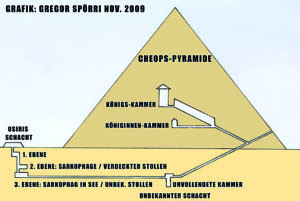
Fig. 7.6 – The connecting passage between the “Cistern” Chamber and the „Osiris“ Complex assumed by Gregor Spörri.
1968 – Experiments with X-ray in the Middle Pyramid by Dr. Luis Alvarez
Technical progress in the 1970s brought with it new types of instruments to help see through solid masses.
In Giza, experiments were carried out for the first time to discover hidden chambers in the “Chephren” Pyramid, headed by the Nobel Laureate in Physics, Dr. Luis Avarez of the University of California in Berkeley.
The results of the “Joint Pyramid Project”, which received financial support from high places, were less than satisfactory, although nearly one-fifth of the pyramid was investigated with x-rays and cosmic rays, extending out in a 35 degree radius from the Belzoni Chamber, where, based on tales, it seemed most likely that further chambers would be found. According to a scientist who was directly involved, the results were confusing, as was also reported by the journalist, John Turnstall, in the British newspaper “The Times“, in an extensive article on July 14, 1969.
“Scientists who have been trying to X-ray the Pyramid of Chephren at Gizeh, near Cairo, are blaffed by mysterious influences which are throwing into utter confusion the readings of their space age electronic equipment. For 24 hours a day for more than a year, in the hope of finding secret chambres thought to exist within the six million ton mass of the pyramid, they have been recording on magnetic tape the pattern of cosmic rays reaching its interior.
The idea is that as the rays strike the pyramid uniformly from all directions, they should, if the pyramid is solid, be recorded uniformly by detector in the chambre at the bottom. But if there were vaults above the detector, they would let more rays through than the solid areas, thereby revealing their existence.
More than a million dollars and thousands of manhours have been spent on the project. (…)
The use of cosmic radiation for probing the interior of the pyramid was proposed by Dr. Luis Alvarez,1968 Nobel Prize winner for physics and director of the Lawrence Radiation Laboratory at California University.
Dr. Amr Gohed, who had been in charge of the installation at the pyramid (…)
Though hesitant at first, he eventually told me of the complete impasse that had been reached.
„It defies all the known laws of science and electronics“, he said, picking up a tin of recordings made in October. He put the tape through the computer, which traced the pattern of cosmic ray particles on paper. He then selected a recording of the next day in October and put it through the computer. But the recorded pattern was completely different. The salient points which should be repeated on each tape were absent.
„This is scientifically impossible“, he told me.
But it is happening before the scientists‘ eyes. Dr. Gohed said that the earlier recordings, which had raised the hopes of a great discovery, were now found to be a jumbled mass of meaningless symbols with no guiding pattern whatever.
„Either the geometry of the pyramid is in substantial error, which would affect our read¡ngs, or there is a mystery which is beyond explanation – call it what you will, occultism, the curse of the Pharaohs, sorcery, or magic, there is some force that defies the laws of science at work in the pyramid.”
Officially it was published that no chamber was found, but there is a picture from the experiment showing a possible chamber in the center.
It was also unusual how the two leading researchers subsequently contradicted each other.
Dr. Luis Alvarez said:
“The devices have worked perfectly. No signs of any passageways or chambers have been found in the area of the 35 degree inclined cone scanned from the spark chamber.”
But Dr. Yazolino said:
“Whenever the neon in the spark chamber was used up, dark spots appeared on the screen that looked like a possible chamber.” According to him, other corridor and chamber systems were recorded in the „Chephren“ Pyramid with IBM electronics.

“Chephren” Pyramid – Graphic from the work of Dr. Alvarez, with the position of a possible chamber in the center of the upper half.
1970 – Use of remote sensing by A.R.E./ECF
To be able to see the invisible is an ancient dream of humanity, especially in Giza. While certain individuals can successfully see using their mental powers (remote viewing); the same goal has also been pursued by technical means (remote sensing).
Stanford Research International (SRI) has been one of the leading companies in this field since the beginning of the 1970s. SRI was founded under the name, Stanford Research Institute, in 1946 as a branch of Stanford University, in order to carry out technical assignments for high-paying customers. Among its clients were the CIA (Central Intelligence Agency) and various departments of the US Army. The cross-connections grew so strong that Stanford University decided to separate from the company in 1969. Under the new name, Stanford Research International, SRI became an independent company, which “today is among the largest think tanks in the USA and which has a annual budget of over 200 million dollars” (Robert Bauval in his book “Secret Chamber”).
SRI is concurrently pursuing both remote viewing and remote sensing. It is now known that both methods were also used while researching Giza. At the beginning of the 1970s, the SRI technical department achieved a breakthrough in the development of penetrating radar. One of the first places this new technology was used was in Giza. However, not in assignment for the CIA or another secret service, but for the Edgar Cayce organizations, the A.R.E. and ECF (see page 179). Thus, the purpose was also not a secret. The intention was to find the secret chambers mentioned by Edgar Cayce along with proof of the lost culture of Atlantis. Almost nothing was published about this; only a little about the investigations, but nothing about the results.
Note on Mark Lehner:
The leading person behind both the A.R.E. and ECF was Cayce’s oldest son, Hugh Lynn, who recognized that he would receive access to Giza research only by placing his own man at the site. So, they came up with a plan to seek out a suitable candidate, who was ultimately found at the beginning of the 1970s in the student Mark Lehner. Lehner made his first trip to Egypt in 1972 with an ECF youth group, led by Edgar Cayce’s grandson, Charles Thomas Cayce. At the end of 1973, he attended the American University of Cairo on an ECF scholarship, and studied there until 1976. The ECF also subsequently financed his internship.
During his studies in Cairo, in 1974, Mark Lehner wrote the book, “The Egyptian Heritage“, which was published by the A.R.E. It included a comprehensive treatment of the statements made by Edgar Cayce about Egypt. Among them was:
“According to the readings (of Edgar Cayce), the heritage will be rediscovered in the foreseeable future and with trailblazing results – not only for the history of the Pharaohic period, but for everything concerning our physical and spiritual development, as well as for the time that lies before us.“
Mark Lehner met the SRI staff member, Lambert T. Dolphin, in Cairo in 1976, which smoothed the way to Giza for the ECF. Mark Lehner also met Zahi Hawass back then, who had already embarked upon his Giza career. A close connection and cooperation arose between the two Egyptologists.
1974 – Chambers in the Great Pyramid with high-frequency waves by SRI
Also in 1974 – somewhat later than for the A.R.E. at the Sphinx – scientists of the Stanford Research Institute, this time in cooperation with the Ain Shams University in Cairo, did research in the Great Pyramid. A newer system radiated through it with high-frequency electromagnetic waves in order to find further chambers. At the beginning it was said that the experiments had started successfully, but nothing was published about it. As always, if they are „private clients“ with their own interests, whose intentions and results should not be shared with the public.
1976 – Investigation in the pyramid with X-rays by university
David H. Lewis, whose discoveries are dealt with in the following chapter, also tells in his book at the end that only a few weeks before his discovery in June 1976 „a caravan of scientists from a Californian university“ had completed their investigation. They would have tried to find secret passages and rooms with gamma X-rays. This investigation would not have revealed anything concrete, only the confirmation of the known chambers and passages. However, they would have found signs pointing to a secret staircase behind the „King‘s“ Chamber and „Queen‘s“ Chamber. He probably also mentioned this as proof of his discoveries.
But I haven‘t found anything about researching a university in 1976 in all the research so far. Maybe he refers to the experiments with the high-frequency waves carried out by the SRI in 1974, if this crew had only left in 1976.
1976 – Chambers under the Great Pyramid by David H. Lewis
The American, David H. Lewis, described in 1978 in his book „Mysteries of the Pyramid“ that in 1936 codes were found in an ancient temple east of Athen – for a secret entrance to the Great Pyramid, which consisted of vibration heights and key words of holy names. They would have studied these encodings for 40 years, decoded them and then carried out 37 tests on site. On June 9, 1976, they opened the secret entrance at the southern tip of the pyramid by sliding a block weighing 15 tons inwards by 2 m / 7 ft and opening a passage of 90 cm / 3 ft to a staircase. The block was not mechanical, there were no visible rails, hydraulics, wheels, chains, lines or magnetic fields. They would have only discovered a groove in the middle of the stone.
According to Lewis, this staircase is the core of the pyramid, and leads down about 299 m / 980 ft in rectangular form. The descent took over ten hours, as they could see almost nothing even with the torches, because each step raised so much dust that it took them more than three minutes to set. The roughly cut passage is only 24 cm / 29 in wide and 1.82 m / 6 ft high. The stairs consist of 57 steps and at the end of the 57th floor was a small platform.
There they came into a small anteroom with rough walls, a vaulted ceiling, marble floor and a heavy metal door. They tried to open them with the same codes as at the stone at the entrance, but it didn‘t work. They tried for hours with sound vibration and the inversion of the original words from the entrance, and others like „Urim“ (light) and „Genesis“ (creation). At this point, the metal door slowly moved upwards and opened another short staircase leading to the first anteroom and then to the chamber with records, which was built in a special architecture and was about 91 m / 300 ft tall.
Thus „one of the deepest secrets of our time“ had been opened to them. He speaks of many artifacts and strange machines, but above all of the countless records of many civilizations on earth and the entire history of mankind – on both sides of our solar system.
On a marble stand, they found a book wrapped in a kind of glass. It was half open and so they photographed it, explored it and decoded it after several years, summarizing that the first human civilizations came to this earth 576,000 years ago.
He describes very precisely the discs made of an unknown metal that were located in long shelves at the entrance area. They were paper-thin metal foils and the tiny white inscriptions on their shiny, greyish surface showed a language that was not comparable to any of the old earthly languages. Their sizes varied from a rectangular shape with 18 cm / 7 in to 36 cm / 14 in lateral length, as well as long and oval discs with a diameter of 18 cm / 7 in. Lewis estimated there were half a million of these slides in storage.
The lighting of the room showed strange machines on the first floor. Some would have been more sensory at the touch of a button. The marker board they had translated as „Antigravitor“ and after several studies they had discovered that this device generated a gravitational field beam that was capable of lifting a stone block weighing many tons so that it could float. For Lewis, it was undoubtedly one of the machines used to build the Great Pyramid.
Lewis describes another large metallic ring with a diameter of 7.6 m / 25 ft, with a tunnel-like depth of 3.65 m / 12 ft. He explains that this ring was used for teleportation (immediate transfer of a body or an object from one place to another, without the use of physical force), which was already used in these ancient times and represented the supreme power of man, since it was only possible and steerable with the power of the mind. In the last room, on the right side of the large chamber, stood a collection of devices that looked very similar to today‘s computers, mobile phones and monitors.
They found another special artifact behind an unlocked metal door. The room was empty except for a miniature pyramid standing right in the middle. According to their measurements, it was a smaller model of the Great Pyramid, which was 232 m / 762 ft wide and 148 m / 486 ft high. But not a real model, as they would have expected, with 19 cm / 7.62 in width and 12.3 cm / 4.86 in height. From its flat tip, a long, thin wire rose 7.2 cm / 2.86 in.
Between June 1976 and May 1977 they had visited these rooms six times to document as much as possible. They would have recorded all images and recordings on around 2,700 microfilms. Lewis writes that her documentation is „only a small part of this shrine, for the records in these rooms are as endless as time itself“.
In November 1979 they had completed their evaluations and translations in rough form, confirming various theories, such as visits by beings from other worlds, early underground civilizations to 7 underworlds and later widely developed cultures on Earth. They would have lived in harmony and peace and tried not to disturb the natural element of the Earth‘s atmosphere, its central energy core. Later it follows that the ascending Egyptians were descendants of the Atlantic race. Lewis ends with the news that a deity created the earth and the world space. Therefore it is about „an expanded perception of the invisible forces of man in the effort to awaken him and to free him from his earthly limits and limitations“.
This is how I summarized their main discoveries. It is one of the special experience reports and to prove all these discoveries would really be a sensation. But even after a lot of research I couldn‘t find anything. Where do you think all these microfilms of images, documentaries and translations have been hidden?
Note on the Sphinx Temple:
Lewis also writes briefly about an entrance to the Temple of the Sphinx as a well-kept secret that is now known to a few after 10,978 years. This temple is a „shrine of extreme beauty and breathtaking splendour, with gold inlays and precious jewels at the altar“. He describes arches of unusual architecture, polished marble walls with pink tones and silver floor inlays with unusual hieroglyphics. Somewhere in the labyrinth of marble walls is a secret door with a downward passage leading to a special tomb under the pyramid…
1976 – Theories of stone blocks of ancient Egyptian concrete
All concrete theories have the origin and the basics in common. It all began in 1889 when the archaeologist C. E. Wilbour found the so-called Famine Stele on Nile Island. It contains around 2,600 hieroglyphics and the columns from 6 to 18 contain 56 characters describing a recipe for the production of artificial stone from 29 listed minerals. There are even places indicated where these materials can be found. However, the stele was not translated until the last century by the archaeologists Brugsh, Morgan and Pleyte, and again in 1953 by the Egyptologist Barquet. They all agree with today‘s geologists that the Famine Stele was only produced in the Ptolemaic phase between 400 and 300 B.C. But the inscriptions report about 2‘000 years ago of the pharaonic dynasties, when gods passed this knowledge on to the earthly rulers. This is how Pharaoh Djoser received it from the Creator God Chnum in his dream. Djoser lived 2609-2590 B.C. and is considered to be the builder of the first Step Pyramid in Saqqara. According to these traditions, his master of architecture, Imhotep, mixed clay, soda, silicates, mud containing aluminium, minerals containing arsenic and sand into a mass that allowed them to produce a rock.
The next basis for the concrete theories is a secondary result that became known in 1974, when scientists from the Stanford Research Institute and Ain Shams University radiated through the Great Pyramid with high-frequency waves to detect further cavities (see page 186). Among other things, nothing had been published at the time because most of the measurement results had been unusable. The reason given is that the high-frequency waves were largely absorbed by the stone blocks because they contained too much water for „natural stone“. Until then, the rock on the Giza Plateau was considered dry, but subsequent calculations showed, for example, for the Middle Pyramid a water content of several million litres! Thus, further „concrete theories“ arose, since according to the proponents, the high water content must be artificial, cast stone.
The renowned Prof. Robert Schoch from the University of Boston, who was already involved in determining the age of the Sphinx, made a geological thesis (see page 62). He scientifically justified that the argument for a „concrete mixture“ was untenable due to the water content, because the rock of the pyramids inside still contained moisture from the times of the Floods and the millennium rain.
In 1976, the concrete thesis received worldwide attention with the book „They built the Pyramids“ by Prof. Dr. Joseph Davidovits, a plastics chemist who worked at the Geopolymer Institute in Paris and at Barry University in Miami. He argues that the 3 pyramids – like other megalithic structures, e.g. Puma Punku in Tiahuanaco, Bolivia – are cast from blocks of an original concrete. He had tried the recipes mentioned according to ancient Egyptian tradition and discovered that a concrete was produced that was even harder and more resistant than today‘s concrete. In 1979, Davidovits developed based on this research a durable artificial stone called geopolymer. He and his team took samples from the 3 pyramids and published that the rock cast for the construction of the pyramids consisted of 93-97% natural lime and 3-7% kaolinite clay as binder. Davidovits concluded that the stone block and ramp theory valid for Egyptologists was therefore invalid. On the one hand, much less workers would have been needed to build the pyramids, and on the other hand, the transport routes would have been eliminated or largely reduced. His team found something strange in a rock sample of the Great Pyramid. Under the microscope, a hair about 20 cm / 7.87 in long was found; But how did it get into or onto the rock? The proponents say it was from a man while mixing concrete, the opponents say it got there during the building of the pyramids.
In the same year, at the 2nd International Congress of Egyptologists, which took place in 1979 in the French city of Grenoble, the rock chemist, Dr. D. Klemm, presented the investigations of his team of stone samples from the Great Pyramid to the experts. They had taken 20 different samples and, due to their different structures, concluded that each block could come from a different region of Egypt because a natural limestone was homogeneous in its density, but the stones examined were denser at the bottom and contained more air bubbles at the top than usual. This was taken by the proponents as proof that each block was manufactured individually. Opponents say that these structures could also arise naturally geologically. The Egyptologists vehemently reject all concrete theories. They refer to the various analyses of the pyramid rocks and limestone blocks that were transported here from the quarries of Tura and Madi.
In 2006, scientists Gilles Hug of the French Research Institute of Aerospace, Michael W. Barosum and Adrish Ganguly of the American Drexel University of Pennsylvania, again examined pyramid rocks with X-rays and plasma light. They published that certain micro-components of the stones show traces of a fast chemical reaction, but this effect is not given with the blocks from a quarry. The refractive spectrum of the rock also shows a deviation from blocks originating from the quarries.
And Guy Dumortier of the Belgian University of Namur has shown that the pyramid stones have a higher fluorine, silicon, magnesium and sodium content than the blocks in the quarries. There are also arguments against this, which say that the differences can partly be explained by the breaking, the transport and the processing. This would be compounded by the influences of the new environment and the time factor, because Giza has had different conditions since the pyramids were built 4,500 years ago.
Note:
If we assume the building of the pyramids in the last Atlantic period, it will be around 13,000 years. For me personally it is clear that the complexes in Giza were built of rock (see Building Declarations, page 161). Also because the concrete theory for limestone does not explain the most important part of the rock questions: the buildings made of huge blocks of red granite, which was transported over 1,000 km away from Aswan.
1977 – Acoustic ground resistance measurements at the Sphinx by NSF/SRI
Interesting results were also achieved in 1977 by the American National Science Foundation supported joint project with the Ain Shams University of Cairo and the SRI, represented by Lambert T. Dolphin (see page 177). The Sphinx was one of six research locations selected in Egypt in which the ground resistance and its magnetic structure was measured, and where multiple anomalies were diagnosed. Among other things, the SRI concluding report stated:
“Several anomalies were observed as a result of our resitivity survey at the Sphinx. […] The team discovered five areas of interest. Behind the rear paws (northwest end) we ran two traverses (Numbers 206 and 207). Both traverses indicate a small anomaly that could possibly be due to a tunnel aligned northwest to southeast. Another anomaly exists in the middle of the south side near a square cupola added apparently in Roman times. This anomaly was verified by two overlapping traverses (numbers 201 and 202). When the electrodes were moved 2 meters away from the previous traverse, the anomaly decreased in value. This is typical of the behavior expected from a vertical shaft.
There are two anomalies in front of the front paws of the Sphinx. […] However, one anomaly occurs on large electrode spacings, suggesting a cavity or shaft as much as 10 m / 32.8 feet deep. The cavity, if present, is probably filled with rubble. […] The resitivity anomalies we found around the Sphinx are not defined sufficiently to allow us any absolutely certain conclusions and we feel that a more detailed survey should be conducted, with the arrays run at 1-m / 3.3-ft electrode spacings and with many more traverses to form a matrix.”
Proposed was the use of additional technology that would enable the three-dimensional representation of all underground anomalies on a map.
1977 – Acoustic ground resistance measurements at the “Chephren” Pyramid
The year 1977 was groundbreaking for Giza research. New experiments were carried out around the “Chephren” Pyramid. Empty spaces or anomalies were determined through acoustic soundings, 21 and 33 m / 68.9 and 108.3 ft below the ground of the pyramid, and also 4 m / 13.1 ft beneath the horizontal passage to the Belzoni Chamber. The Egyptian authorities even granted a permit for special drillings, which, however, ultimately failed for financial reasons.
Comment on Zahi Hawass:
Dr. Zahi Hawass was named Chief Inspector of Antiquities at the Giza Pyramids in 1977. As representative of the Egyptian Antiquities Authority, he issued Mark Lehner and the ECF (see page 179) a permit to investigate the Sphinx. The SRI team member, Lambert T. Dolphin, met with representatives of the ECF in the USA at the end of the year. At this meeting, it was agreed that the SRI would carry out further investigations in Giza for the ECF with the goal of finding the Hall of Records mentioned by Edgar Cayce in his trance readings. According to various sources, the ECF paid 100,000 US dollars in advance for this assignment.
1978 – The Sphinx Exploration Project by ECF/SRI – The investigation agreed upon between the SRI (see page 179) and the ECF – entitled the Sphinx Exploration Project – lasted from January to March 1978. ECF founder, Hugh Lynn Cayce, also traveled to Giza to witness the explorations first-hand. The young Egyptologist, Mark Lehner, promoted by the ECF, hoped to find confirmation of the views he had published four year prior in his book “The Egyptian Heritage”, which threatened to derail his academic career.
Five drillings were carried out at the Sphinx, although the ECF license did not limit such. However, the license only permitted those that could be justified on the basis of the SRI research showing unambiguous anomalies. Technical problems also followed on the heels of the internal ones. Because of the high level of the water table, the measurements did not show any clear results below a depth of 4 m / 13.1 ft. Moreover, the possibility exists that the empty spaces and chambers were filled with debris. Considering that some of the known subterranean Giza complexes lie 30 m / 98.4 ft deep and more below the surface of the earth, then the measurements can be viewed as somewhat superficial.
The Sphinx Exploration Project was discontinued after three months. No thorough research report was ever published. SRI and the Egyptian Antiquities Authority published no information at all, while the ECG report was formulated in a diplomatic and veiled style. The question remains: Did these institutions literally throw 100,000 dollars in the sand, or have they suppressed their findings to keep them from becoming public knowledge? Years later, the author, Robert Bauval (see page 209), learned that the research work conducted back then had been filmed and was able to get access to a six-hour raw cut of the materials. He published statements from this film in 1999 in his book, “Secret Chamber“.
According to Bauval, Hugh Lynn Cayce and Mark Lehner both confirmed before the camera that the sole purpose of the Sphinx Exploration Project had been to find the Hall of Records that had been described by Edgar Cayce. Hugh Lynn Cayce stated that the primary borings were made in the front right paw of the Sphinx, because this was the location his father had named.
“He [Edgar Cayce] never said that it [the Hall of Records] would be found under the front right paw; he said that the entrance to the passageway would lead from the front right paw. Of course, this leaves a great deal of leeway as to where this shaft beneath the paw could be.“
(The front paw of the Sphinx is 15 m / 49.2 ft long.)
In the film, Mark Lehner, while standing before the Thutmosis Stele between the two front paws of the Sphinx, made reference to ancient Egyptian documents:
“For example in the tablets that Selim Hassan found left behind by pilgrims. They often show the worshipper standing in front of the Sphinx, in front of a depiction of the Sphinx of Giza here, and there were some 60 of these tablets found. And the majority show the Sphinx standing on a high pedestal with a door at the bottom. Just as the Thutmosis stela here (Lehner is sitting between the paws of the Sphinx) where the Sphinx is sitting on top of a pedestal with a door at the bottom. […] Interestingly… some of the tablets, refer to the Sphinx and the Sphinx sanctuary as the ‘chamber of Sokar’… the same god which appears in the secret chamber between the paws of the Sphinx in this tomb painting [from the tomb of Seth] … (Thothmoses IV) calls the Sphinx the ‘sanctuary of Sokar’… so you have the question: in the minds of the ancient Egyptians who composed this sacred book on the king’s tomb wall – the Book of What is in the Underworld – when they show the secret chamber in the Sphinx in a place called Rostau, which is called the ‘secret place’, and when you think that this place (Giza) was called Rostau, and was also said to be the ‘Sanctuary of Sokar’, the god of the secret chamber, did they know, or did they have the idea, that there was a secret chamber under the Sphinx as far back as 1,500 BC? Is the legend, or the mystery, or the myth of the secret chamber under the Sphinx as old as that? In the tomb paintings, the Sphinx is also called Aker, the guardian of the entrance of the Underworld.”
Aker (Sphinx) – The line drawing of Aker and Thoth.
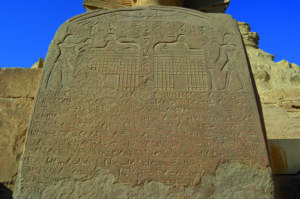
The stela of Thutmosis, with the mirrored Sphinx representation, which also serves as the basis for the serves for the theory of a second Sphinx (see p. 257).
1978 – Pyramid exploration by RSI/SRI
At the same time, SRI also worked for another company in Giza for the two large pyramids, RSI Recovery System International. Later it turned out that there was a connection between the two clients, because the RSI had been founded by ECF sponsor Joseph Jahoda for this research project. For reasons still unexplained, it was abandoned after a short time. According to Mark Lehner, there were disagreements because RSI did not agree with the „Cayce component“; Joseph Jahoda, however, said that the drilling had been stopped by the Egyptian military.
1978 – Replica of the Great Pyramid by Dr. Yoshimura/Nippon Corp.
On a research trip to the pyramids in 1978, Dr. J.J. Hurtak was able to film a group of construction engineers from Japan (Nippon Corporation) who began with a reconstruction of the Great Pyramid (www.youtube.com/watch?v=SjWu7syfXdY).
He later told me about this experiment and that the film is one of the few scientific documents to produce and construct corresponding limestone blocks according to the basic requirements of 4,500 years ago, such as tools, ramps and workers.
The project was led by Dr. Sakuji Yoshimura, an archaeologist from Waseda University, who also did research in Giza several times later (we come back to his discoveries). His goal was to build a smaller model of the Great Pyramid, almost 20 m / 65 ft high and 30 m / 96 ft wide, thus proving the current building theory. However, the size of the Japanese pyramid was somewhat embarrassingly reduced already in the first days when its builders noticed that they could not procure and could not afford the required limestone.
It was then almost impossible to build the smaller compromise pyramid, almost 11 m / 36 ft high and 15 m / 50 ft wide. Each standard block of limestone, although reduced in the same ratio, was only 90 cm / 3 ft in the cube, but weighed almost 3 tons.
In the end, even in the lower layers, it proved too difficult, time-consuming or even impossible to continue with the methods and possibilities of the time. Therefore, after many delays, the Japanese used modern means to erect at least their small model, including two cranes and a forklift. In the end, they proved scientifically that it was not possible to create the Great Pyramid with conventional Egyptian building theories.
1978 – Chambers in and under the Sphinx by the „Guardian of the Pyramids“
One of my long-term partners, who is almost 70 years old today, lived his whole life in Giza. He told me that in 1978 the Sphinx was briefly open on the left side and had an entrance. There had been researched secretly for months and he then went in once in the night himself. First he went through a hole and after 2 m he reached a large cavity. From there, after 6-8 m, a shaft of his estimate led slightly obliquely down into the middle of the Sphinx. There was a soft ground and he assumes that digging had taken place by then. But there could also have been a lid underneath, which had been filled up with sand. For him this was the confirmation of what his grandfather had told his father, because between 1932 and 1935 he had been several times in the Sphinx and below in chambers, and from a large chamber had continued 3 courses. This also coincides with other stories and evidence (see graphics on page 99). My friend also gave me photos of an acquaintance showing how the left side of the Sphinx – and thus also the entrance – was bricked up afterwards. For security reasons, he does not want to be named by his name, but as „Guardian of the Pyramids“. I trust him because he has already worked with Said, West, Bauval, Hancock and other well-known researchers.
Note: In the 1930s, his grandfather was with friends in the Great Pyramid in the „Cistern“ Chamber and from there entered a passage leading to the Sphinx. However, my friend could not tell whether the passage started from the „Unfinished” Shaft, from the pit or from another place. This would also confirm the often suspected course, as well as Gregor Spörri‘s thesis that it leads to the Sphinx (see page 189).
1978 – Sphinx Renovations 1920– 2018
I am including this chapter here after 1978, so that it is in context and because the renovations have increased since the 1970s. From the 1920s onwards, the outside of the Sphinx was repeatedly repaired, renovated and rebuilt. As early as 1925/26, the two front paws were completely re-covered. From the sixties and seventies the side panels followed up to the middle of the Sphinx body (see graphic). Some of these works had been carried out improperly, which did more harm than good to the enormous statue. It began in the 1920s, when the Sphinx was filled with cement, but his put even more strain on the porous limestone and caused cracks that spread over the entire body of the lion. The remains of the gypsum mortar, which did not dissolve by themselves, were later removed again, but in the case of cement this was only partially possible. Nevertheless, cement was used again later, you can still see it well at the back of the head and neck. In almost every “renovation” there were rumours that these were accompanied by secret excavations in and under the Sphinx. Since 2012, the rising groundwater level, caused by the new wastewater system in the neighboring Nazlet Al-Seman district, has been the main cause of the increase in porous rock. From 2014 onwards, water was pumped out on a large scale, but as the Minister of Antiquity, Mamdouh el-Damaty, confirmed, no research and restoration work had yet been carried out for the damage under and in the core of the Sphinx rock.
Note:
Some of the chambers under the Sphinx may now also be under water.
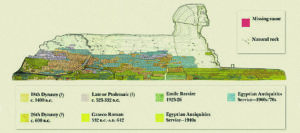
Sphinx – Stages of exterior cladding from 1400 B.C. to 1960/70 by the Supreme Council of Antiquities.
1980 – Discovery of pink granite in the ground beneath the Sphinx
A close relationship grew between Hugh Lynn Cayce and Zahi Hawass in the course of the Sphinx Project. Cayce promoted the academic career of Hawass (dissertation) in the USA in order to remain up-to-date with the latest Giza exploration. From him he learned of a significant discovery: When Hawass carried out excavations northeast of the Sphinx in 1978, just below the surface he came upon a hard subsurface. This means that in this area in front of the Sphinx, an underground “cliff” exists which can hardly be attributed to natural causes. In September 1980, the Egyptian Ministry of Irrigation and Water Resources conducted borings of this material 15 to 20 m / 49.2 to 65.6 ft east, in which the hard stone was only reached after going through a 16 m / 52.5 ft thick layer of fill material.
This was made clear by the fact that the hard subsurface that the drill came upon consisted of red granite, which does not occur naturally in Giza, but had to be transported from Aswan over almost 1,000 km. We find this pink granite so far only used in the monumental pyramids and in the Valley Temple in front of the Sphinx. The size and thickness of the granite surface could not be determined by a one-time drilling. The discovery was highly explosive. However, since the area relevant for research extends deep into the Cairo Nazlet-el-Saman neighborhood, further drilling and excavations would meet with hefty resistance by the population. This is the official reason that no further research has been carried out.
This information has been taken from the ECF report by Edgar Evans Cayce in his book “The Atlantis Secret“, from which the illustration 7.35 has also been taken.
The discovery of pink granite in the ground below the Sphinx was also mentioned by the authors Robert Bauval and Graham Hancock in their co-authored book “The Message of the Sphinx“:
“At the same time, Zahi Hawass, today the Director-General of the Giza Pyramids, was supervising excavations 165 feet to the east of the Sphinx Temple and hit bedrock at a depth of only six feet. A few months later, however – in 1980 – Egyptian irrigation specialists checking for groundwater drilled in the same area, less than 100 feet away from the Hawass dig, and were able to go down more than 50 feet without impediment before their drill-bit suddenly collided with something hard and massive. After freeing the drill, much to their surprise, they found that they had brought to the surface a large lump of Aswan granite.
No granite occurs naturally anywehre in the Nile Delta area where Giza is located, and Aswan – the source of all the granite used by the ancients at Giza – is locaded 500 miles to the south.
The discovery of what appears to to be a substantial granite obstacle – or perhaps several obstacles – 50 feet below ground level in the vicinity of the Sphinx is therefore intriguing to say the least.”
Up to 150 years ago, the area east in front of the Sphinx was considered to be nothing but an expanse of sand and rubble. When the first excavations were carried out there, the Sphinx Temple and Valley Temple were discovered just a few meters / feet below the surface. The drillings made by the Ministry of Irrigation and Water Resources in 1980 led to the discovery that the stone subsurface found 50 to 80 m / 164 to 262.5 ft east of the Sphinx Temple, plunges sharply after around 15 m / 49.2 ft and in front of this is a surface made of red granite – a typical material used by archaic megalithic builders. Perhaps there once stood in this place a temple made of granite or a landing for the long boats (picture page 158).
Remarkably, this spot matches a location named by Edgar Cayce in his trance readings: “between the Sphinx and the river”.
Note: Therefore, after this discovery in 1980, official policy in Giza entered an entirely new phase. While the official research continued in the service of supporting the pharaohic version and used to divert the public from the fact that something sensational was to be discovered in Giza, planning began on a secret long-term project to explore the underground complexes.
1980 – Sphinx Mapping Project by ARCE
Around 200 archive photos were found in a Paris institute in 1980, which documented explorations at the Sphinx that were conducted from 1925 to 1936, however, about which no official report was ever published. Edgar Evans Cayce, the younger son of Edgar Cayce (see page 174),
described the photographs in his book, “On Atlantis” as follows:
“The photos show that archaeologists removed much of the Sphinx’ stone cloak when the Sphinx was excavated in the 1920s. The archaeologists even dug into the body, probably in search of hidden chambers. Two or three pictures seem to show a kind of cavity in the northern part of the middle body in which a man was standing, but at a slightly lower level than that of the earth’s surface. Another photo clearly shows a hole in the southern hind paw. These forms were all covered again with the old stones and modern cement.”
From 1934 to 1936, the Egyptologist, Dr. Selim Hassan (see page 179), discoverer of the “Water Shaft”, or “Tomb of Osiris”, conducted research near the Sphinx. In the process, he removed the sand that had accumulated in the Sphinx trench since the last excavations in the 1920s and bolstered several damaged sections with stones. In this book, “The Sphinx: Its History in the Light of Recent Excavations”, published in 1949, he stated:
“As to what the exact age of the Sphinx is and to whom we can attribute its erection, no definite facts are known, and we do not have a single inscription from that time that would give us an answer here.”
The discovery of the old photos occurred in connection with the so-called ARCE Sphinx Mapping Project, which was started at the end of the 1970s. Around that time, the Egyptologist, Mark Lehner (see page 186), began working closely together with the American Research Center in Egypt, founded in 1948 (ARCE). The poor condition of the Sphinx, which was clearly shown by the research conducted in 1977 and 1978, alarmed experts in the field, and especially Mark Lehner. He proposed that further research be conducted, whereupon the ARCE and the Egyptian Antiquities Organization (EAO) launched the ARCE Sphinx Mapping Project, in which the ECF (Edgar Cayce Foundation) was again the primary sponsor.
A detailed recording of the Sphinx was made from 1979 to 1982 and the area around it was mapped. In the process, the shaft behind the Sphinx was opened. It was discovered in 1926 and then walled up because it only led down a few meters / feet. In 1980, Mark Lehner, together with James P. Allen of ARCE in Cairo, and K. Lal Gauri, Director of the stone conservation laboratory at the University of Louisville, Kentucky, published an interim report (The ARCE Sphinx Project: A Preliminary Report”, which appeared in number 112 of “The ARCE Newsletter“), in which an important observation was made:
“Except for the prominent boss on the chest, we have nowhere observed any kind of working marks on the core body, either in the way of tool marks or of surfaces that would seem to have been left by rough quarrying activity.”
There is a simple explanation for this, according to the authors, who point out the strong traces of erosion, which would explain why no traces of the original quarrying work were to be found. They also determined that the Sphinx must have already been very greatly weathered at the time of the first repairs that were made. The authors, who were solidly convinced that the Sphinx was built by the Pharaoh Chephren, dated the oldest repaired areas on the Sphinx to 1440 B.C. They believed that the time span of around 1,000 years would have been sufficient to explain that degree of weathering.
Critics of this conventional view, especially the Geologist, Robert Schoch (see page 59), point out that the Sphinx was probably covered with sand more than half of the period between 2,500 to 1,400 BC, and that other structures from this period do not show anything approaching that level of erosion. It would seem that Mark Lehner already was representing the views of official Egyptology and was – at least to all outward appearances – a vehement opponent of all those who insisted that the Sphinx is older than 4,500 years and that the pyramids were not built by the 4th Kingdom pharaohs. What cause him to change his mind?
1980 – Discovery of mine in Assiut, 33‘000 years old
The discovery is not directly related to the buildings in Giza, but it shows an interesting time frame in relation to the Atlantic period. In the early 1980s, archaeologists from Belgium discovered what is probably the oldest mine in the world near Assiut, some 380 km from Giza. Around 33,000 years ago, flint was mined there on a large scale, which was proven by the age determination of coal residues.
1982 – New interest groups in Giza (Giza Plateau Mapping Project)
Following the Sphinx and the area around it, the mapping of the entire Giza Plateau was begun in 1982. The so-called Giza Plateau Mapping Project was headed by Mark Lehner, Zahi Hawass and the ARCE (American Research Center). Among the project‘s main sponsor was Yale University, with minor support from the Edgar Cayce Foundation (ECF). This meant that the most influential sponsor assumed the leading role. The participation by Yale University is documented in the official project descriptions and is undisputed. More diffuse, however, remains what lie behind this commitment, particularly in view of the Yale’s fraternities, lodges and secret societies, from which the American intellectual elite is often recruited.
Its special role was even a topic discussed in Europe in the run-up to the American presidential race in 2004. The renowned Swiss newspaper, “Die Weltwoche“, presented an article entitled “US Presidency: Built Upon Bones“ in its March 11, 2004 issue covering the American political race:
“The “Skull and Bones Society” is one of the most notorious secret societies in the USA. For the first time, two of its members are dueling for control of the White House. […] Each year in a windowless, sandstone building on the ivy-league campus of the famous Yale University, in a wild annual ritual, a select circle of fifteen students are initiated in the USA‘s most notorious secret society. […] US President George W. Bush drank blood back in 1968 in the Yale dungeon and kissed the “Pope‘s“ [the Skull and Bones leader] slipper, just as had his father George H. W. and grandfather, Prescott, before him. In unparalleled fashion, the Bush Clan is “built upon bones“ in the common jargon. The Bushes owe a great deal to the network of “bones“ men, which in 1992, the arch-conservative Pat Buchanan, accused his opponent, George Bush Senior of attempting to set up a secret society government. […] The Skull and Bones Society is the oldest and most powerful of the seven secret societies at Yale, founded by William H. Russell, member of a notorious opium dealing family.“
After the first remote-sensing research experiments (see page 181) carried out by Stanford Research International (SRI), which led to the discovery of the granite structure beneath the ground in front of the Sphinx, new interest groups quickly became active. Headed by Mark Lehner in 1982, SRI conducted conducted further research at the Sphinx and again discovered an anomaly. Mark Lehner then founded the Ancient Egypt Research Associates (AERA) in 1985, creating a new organization in the field of Giza research.
1986 – New discoveries through remote sensing by Dormion and Goidin
For a brief period in the 1980s, major progress in the technique of remote sensing opened a window of welcome for independent research teams, who for a short time, were even accepted by the Egyptology insiders. In the summer of 1986, two architects from France, Gilles Dormion and Jean-Patrice Goidin, took measurements in the “Cheops” Pyramid using electronic detectors and radar devices. Dormion and Goidin detected anomalies in the horizontal gallery, the corridor that leads to the “Queen’s” Chamber (see page 180), which indicated the presence of three or four hollow spaces. The radiographs made with a gravimeter also showed a deficit in mass in the northeastern corner of the “King’s” Chamber.
Gilles Dormion and Jean-Patrice Goidin then received permission from the Supreme Council of Antiquities to drill several small holes in the passage to the “Queen’s” Chamber. Zahi Hawass, the Chief Inspector of Antiquities at the Giza Pyramids was in the USA during this period. Dormion and Goidin actually did find a hollow space in the west wall of the passageway, after drilling 2.6 m / 8.7 ft. The hollow space was 3 m / 9.8 ft tall and was oddly filled with fine quartz sand. Although the two Frenchmen shared the opinion held by the official Egyptology that Cheops built the great Pyramids, and the last thing they sought to do was to disprove this generally held view, they were refused permission to conduct their research. The discoveries made by the French team contradicted the reigning Egyptology explanation of the pyramid as a tomb and attracted much attention. Especially when Japanese explorations confirmed their results in January 1987, in “Science Frotniers Online”:
“Japanese and French experts are studying a new mystery in the pyramid: Why did the Pharaohs build geometric hollow spaces in the Great Pyramid of Cheops and then fill them with sifted sand, enriched with minerals? Viewed from outside, the pyramid appears to be built of solid limestone blocks. However, two French architects, Gilles Dormion and Jean-Patrice Goidin, discovered hollow spaces that could comprise 15% to 20% of the entire structure. The French team used an instrument that measures differences in gravitation, which enables it to locate hidden hollow spaces. They then drilled small holes through the 1 meter / 3.3 feet thick stone blocks, and discovered sand. However, this was no ordinary sand from the desert just outside. Laboratory tests showed that the sand came from another region of Egypt, which was sieved and then enriched with certain minerals, before being placed inside the pyramid by those ancient architects. A Japanese team then confirmed the results of the French team.” (Science Frontiers Online, No. 55, Jan/Feb 1988, www.science-frontiers.com)
They published their research results in the books “Khéops: Nouvelle Enquête” (1986) and “Nouveaux Mystères de la Grande Pyramide” (1987). They wrote that the hollow spaces that are known to be within the pyramid are predominantly on the eastern half, which could indicate that there are also some on the western side.
1987 – New chambers found in “Cheops” Pyramid by Waseda University
The team of Japanese scientists from the Waseda University in Tokyo, headed by Professor Sakuji Yoshimura, used the latest electronic x-ray machines to examine not only the passageway to the „Queen‘s“ Chamber and the chamber itself, but also the „King‘s“ Chamber and the ground between the “Cheops” Pyramid and the “Chephren” Pyramid, the area around the Sphinx and the Sphinx itself. Among the tools they employed were two different radar systems: one for measuring underground reflections and the other for seeking out hollow spaces using radar transmission.
That same year, Professor Yoshimura published a 60-page scientific report about the research projects (Non-Destructive Pyramid Investigation – By Electromagnetic Wave Method (Waseda University, Tokyo 1987)). The radar recordings detected hollow spaces in the “Cheops” Pyramid along the Great Gallery and southwest and north of the “King‘s” Chamber, as well as a passageway that led away from across the entrance to the “King‘s” Chamber. The radar also detected a 30-meter / 98.4-feet long corridor in the northwest corner of the “Queen’s” Chamber, which runs parallel to the known horizontal corridor, which matched the hollow space that the French architects had located a few months prior.
The devices also recognized underground chambers and corridors at the Sphinx. The following measurements were provided by Professor Yoshimura in this report:
“1.) Area south of the Sphinx: […] A response was obtained which would indicate that there is a hollow space 2.5 to 3 meters / 8.2 to 9.8 feet below the ground surface near the south-eastern forefoot. On its body, a groove with a width of 2 meters / 6.6 feet, a depth of 3 meters / 9.8 feet, and a length of 2 meters / 6.6 feet was found which seems to extend underneath the body. […]
2.) Area north of the Sphinx: […] On the body, there is a groove similar to that on the southern part, which seems to extend underneath the body. Under the Sphinx, therefore, there may be a tunnel. Further, near the front elbow, a geometrical cavity (1m x 1.5m x 7m / 3.3ft x 4.9ft x 23ft) has been detected, possibly containing metal or granite.
3.) Area east of the Sphinx: […] Between both the forefeet, a geometrical cavity (1.5m x 3m / 4.9ft x 9.8ft) has been detected. The bottom has not been detected clearly, because the it may be uneven or there may be some articles contained within the cavity. The cavity seems to extend from the east to the west, i.e., toward the chest; however, an offering table made of granite prevented survey. At the western part beyond the offering table […] was not measured correctly due to violent turbulent reflection on it. Rough survey has indicated the great possibility of the presence of a cavity 1 to 2 meters / 3.3 to 6.6 feet below the surface. This cavity may be connected to the cavity located in front of the Sphinx, and may extend into the Sphinx. itself”
On the Waseda University website there can still be found a short summary of the former research project, which was discontinued for reasons that are clouded in mystery:
“A survey of the pyramid group and other relics on the Giza Plateau, 15 km southwest of Cairo, started in January 1987. This survey was unique in that advanced scientific technologies were applied, thus avoiding any sort of destruction to the site. (…) For instance, the electromagnetic wave radar exploration system is capable of exploring the internal space and of detecting any foreign material within the stone structure by the abnormal reflections from inside the stonework by means of radar. Appling this method, fruitful results have so far been obtained, including some unusual radar reactions, which suggest the existence of some inner cavities at the locations at the north side of the Queen‘s Chamber within the pyramid, and the south side of the Great Pyramid and the north side of the Great Sphinx.“ (“The Pyramid Survey at Giza“ www.waseda.jp)
Following the research by the French and Japanese teams, the “Cheops” Pyramid was closed to visitors for several months. Eyewitnesses report that a vast amount of work was carried out in the Great Gallery and in the Queen‘s Chamber. The results of the remote sensing activities were also not refuted by the Egyptologists.
Even Zahi Hawass was quoted as follows at the end of an article in the New York Times, on February 24, 1987, entitled,
“Technology Opens Ancient Doors“:
“French and Japanese scientists have reported encouraging results using similar techniques in search of hidden chambers in the Pyramids and the Sphinx at Giza.“
In 1987, Zahi Hawass returned to Egypt after a period in the USA and was named Chief Inspector of the Pyramids in Giza and Saqqara. The discoveries by the French and Japanese research teams led to the hosting of an international conference, from September 14 -17, 1987; which, however, remained inconclusive, with no concrete results.
The “Cheops” Pyramid was closed at the time of the conference, and was reopened at the beginning of 1988 – but thereafter was more often closed to the public than had been the case in the past. What were they searching for, or perhaps, even found?
1988 – Sphinx shafts by the Supreme Council of Antiquities
These pictures were taken the year after the Waseda University team completed their last examination at the Sphinx. I received them in 2012 from an acquaintance from the Supreme Council of Antiquities, and they show details of the two already known shafts of the Sphinx.
According to the Egyptologist Emad Fahmy, the shaft in the back leads to ground level, i.e. around 12.5 m deep. I hope to inspect this shaft myself in 2018.
The shaft at the back of the Sphinx – also called „Blind Shaft“ or „Grave Robber Shaft“- leads about 8 m deep into the underground, to the place where it suddenly ends. In addition, another shaft leads up from the access gap, which was closed after about 4 m with wooden beams. Through a larger gap you can see that the shaft leads even further up. This could be an access to the space in the Sphinx mentioned in various sources.
Note:
I could not find any pictures of the almost unknown shaft in the head of the Sphinx, which is about 2.5 m deep, in the last 20 years. From the access only (see page 183). There are also no photos of the shaft behind the Dream Stele. Once a night I was inside, I couldn‘t take any pictures. It was about 2 m deep, but filled up with sand and rubble. And with all 4 shafts there is the same thesis, they were bricked up and then covered with sand.
This is an excerpt from the book GIZA LEGACY.


